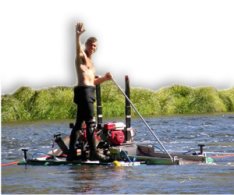I don”t know why it is; but more often than not, the very best gold is just out of reach. It is like the universe is putting us to the test to see if we deserve to find the really good stuff. I usually only gain access to rich deposits when I make the extra effort to get out where it is more difficult. This sometimes requires extreme effort! It takes a lot of discipline to exert extreme effort when you are not sure that what you are looking for is even going to be there. Your head has to be in the right place. But this is the way I find high-grade gold! High-grade comes easier to some others.
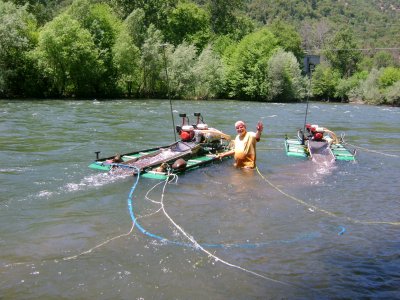
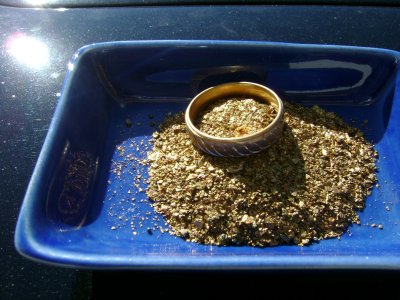
Towards the end of June on a recent season, Mark Chestnut, Jim Yerby and I found ourselves dredging for gold along a stretch of fast, deep water on the Rogue River about a mile below Gold Hill in southern Oregon without very much gold to show for the effort we had invested so far. Our two-week target to locate high-grade gold was nearly up, and all of us were beginning to feel like we were just spinning our wheels. You know that feeling? It’s like doing a heck of a lot of work for almost nothing!
I had seen several dredgers in this particular stretch of river during the previous season. And even though they said they were not doing very well, all their body language gave me the feeling like they were doing pretty well. The problem was that they were dredging way out in the middle of the river, a place which was going to be difficult to reach with the water still flowing high and fast. Nobody was dredging down there yet this season. Conditions were still too difficult.
I took the first dive on this particular sample, with Mark and Jim topside attempting to prevent the dredge from submarining while I was dredging the deep, fast center-part of the river. “Submarining” is when the front of the dredge dips underwater and then gets forced down by the current, ultimately ending up with the dredge upside down in the water. I have been there and done that. It is not fun!
Submarining is a real concern when you are dredging in deeper water, because the weight of streambed material in a longer stretch of suction hose that is not sitting on the bottom of the river will sometimes pull the front of the dredge underwater. Fast, deep, water is even worse, because the strong current usually completely suspends the entire suction hose (placing all the weight of the suction hose on the front of the dredge), and the strong drag against the hose can cause nearly any dredge to take a dive. This was nothing new to our team, since we had already been sampling deep, fast water for two weeks.
A big rain storm upstream had caused the river to run turbid on this particular day. I only had about two feet of visibility on the surface. Doing the best I could, I crawled out into the river on a shallow shelf of some ancient cemented gravel. We have found that there is a lot of this “false bedrock” along the Rogue River.
The fast current swept the suction hose back as I was crawling out into the river with the suction nozzle in hand. I didn”t have any good traction on that slick surface, so I got dragged out with the hose, and was thinking, “Here I go again!'”
Extreme conditions require extreme solutions: This is not something I would advise others to do. But sometimes in dredging situations like this, the only way I have found to get out into the middle of the river is just allow the current to sweep me out there with the suction hose and hope that I will get dragged across something along the river-bottom that I can get a hold of. Then I start a sample hole from there. I do this by crawling straight up in front of the dredge to the end of my suction hose, in this case 25-feet upstream, with a firm grip on the suction nozzle.
Jim Yerby and Mark were managing the dredge on topside with ropes on this particular dive. Their objective was to allow the dredge to get pulled out as far towards the middle of the river as possible, without allowing it to do a full submarine dive. Then I made a full charge towards the middle of the river along the bottom as the current on the suction hose swept me around in a 25-foot ark.
Using this method, once I get out as far as I believe the circumstances will allow, I start trying to capture a hand-hold along the bottom without surrendering the suction hose to the current. Sometimes, I cannot make it happen and end up down below the dredge at the end of the suction hose. Sometimes I do not make it on the first try, but I see a starting point that I can try for on another attempt.
I know this method may seem risky to some people. And it is. There is risk anytime you do something in the water. For some, it is more risky than for others. The more extreme the conditions are, the less margin there is for error or surprises. I almost drowned on a project in Cambodia several years ago when I was using this very same method and my airline got caught around the base of some boulders, trapping me out in the fast water with my air supply kinked off. That was a close one!
The thing is, we could have just waited two or three weeks to sample this section of the Rogue, and most of the serious risk to Mark and I would have been reduced with the slower, summer flows. But we didn’t want to wait; we wanted to get into some high-grade!
When I swept around into the fast water in this place, I was immediately surprised to discover that the shelf ended and the river dropped straight down about 12 feet to the bottom of the river. While in free-fall from the shelf, with the poor visibility, I had no idea how deep it was going to go. It was pretty scary. This, by the way, is one of the reasons we tie our suction hose off to the dredge with rope. Worst case, if all else fails, I can always try and shimmy up the 25-foot suction hose to safety.
The sudden drop into deep water shook me up a bit. But with 90 pounds of lead strapped to my waste, all I could do is go with it and hope my ears would clear with the increased pressure. Fortunately they did. Visibility was only about a foot in the deeper water. So I landed on the bottom before I even saw it.
It took a few seconds for me to reset my internal foundations (get over the trauma and fear). My air supply was still working alright and warm water was flowing into my suit. This meant that I had not sunk the dredge when I dropped over the edge with a death-grip on the suction nozzle. That was good! Mark told me after the dive that he had to put his full body weight on the backside of the dredge to keep it from submarining when I got dragged off the shelf with the suction hose.
It is good to have good support when you attempt difficult operations like this! Here is an introduction to Mark Chestnut. We have been dredging together off and on since 1987, and even had a great adventure together in Borneo:
While the fast water was pulling really hard on my suction hose, I was able to maintain a fixed position on the bottom of the river and get a sample hole started. This is always the most challenging part, because you have almost nothing to help you hold a position on the bottom of the river. Once you get a hole going about the size of a wash tub, things get quite a bit easier. I don’t really mean “easier.” I mean less difficult. Sometimes, holding the suction hose against fast waster can require so much effort that my arms go numb. But if I let go of the suction hose, chances are that I will never be able to get the hose back into the sample hole unless I start all over again with the hose up in front of the dredge and make another jump for it. It is easier (less difficult) to just tough it out and capture the sample on the first try!
This sort of extreme sampling is something we do in a first effort to find high-grade in fast water or on a wide section of river. Then, once we find the gold deposit that we are looking for, we try and rig up something different so that we can work the deposit with less physical effort all at once.
Along the bottom of the river, I found hard-pack which was so compacted that I first thought it was the cemented gravel. But it wasn’t. The material came apart with some effort. The hard-pack here was only about two feet deep, sitting right on top of the cemented gravel. Cemented gravel in this area would require more than a suction dredge to pull apart. Water visibility on this day was too poor for me to slow down and look for gold. So I invested all my effort into sucking a sizable amount of material through the dredge.
My arms were exhausted after about an hour of holding the suction hose against the strong current. I had sucked enough material to get a good idea of how much gold was present. So I let the suction hose go and surveyed the steep cliff towards the side of the river to try and find a route back to the surface. There wasn’t one! You cannot just swim up there wearing 90 pounds of lead, and you cannot jump that far. If I tried jumping for it, the strong current would sweep me to the end of my airline even before I touched down on bottom, again! That would not be good.
This drop-off from the shallow shelf on the side of the river was like a vertical underwater cliff. Poor visibility prevented me from seeing how far it was to the top. There was no way that I could find to get up the cliff except to try and pull myself hand-over-hand by holding onto rocks protruding from the cemented gravel which provided poor, slippery hand-holds. The current swept me off the wall twice and I ended up down at the end of my airline, a place I do not like to be. This is the same as being at the very end of a rope over a bottomless pit. I just barely made it to the surface on the third try. This was a dangerous place to dredge!
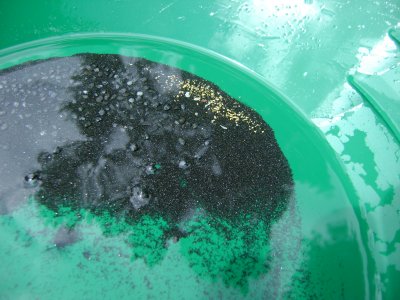 Here was the gold from a handful of material from the upper-end of the sluice; definitely a good sign!
Here was the gold from a handful of material from the upper-end of the sluice; definitely a good sign!
We were totally surprised to see how much gold was in the clean-up! Nearly all of the gold was in the form of tiny flakes. The bottom of the river here was packed with fine gold! We still needed to do another sample to confirm the deposit was more than a small star-burst. I have turned up good initial sample results a number of times, only to find out afterwards that there was no workable high-grade deposit present. But a second positive sample in near proximity is usually something to get excited about. Still, Mark, Jim and I were feeling pretty good about this. It was the best sample we turned up in two weeks of effort. Our level of enthusiasm had been turned up a notch or two.
The water in the river had cleared up quite a bit by the following day. We moved the dredge forward some distance and repeated the same exercise with me getting dragged off the shelf by the strong current into the depths of the Rogue River. It was all easier the second time, because I was expecting the steep drop and I could also see better on the bottom with four or five feet of visibility. Still, it was everything I could do to get the sample done while holding 25-feet of 5-inch suction hose suspended against that strong current. The results from the second sample were about the same, millions of small flecks of beautiful gold! We found a new pay-streak!
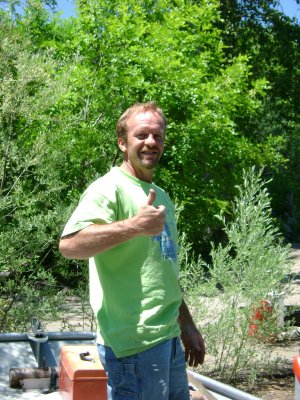 Jim Yerby captured our excitement in the following video sequence shortly after we confirmed the gold deposit:
Jim Yerby captured our excitement in the following video sequence shortly after we confirmed the gold deposit:
From earlier experience, we already knew the Rogue River is loaded with fine gold. So I had retrofitted this 5-inch dredge with a special double-screen classification system; the purpose which is to direct finer particles of gold into a more-protected, slower-moving recovery system where smaller-sized gold can drop out.
The best way to see how well a new recovery system is working is to dredge a bunch of gold into it. Mark, Jim and I took our time to establish where most of all this fine gold was stopping in my box. Fortunately, most of it was in the top third. And there was almost zero gold in the final portion of the box. Things were looking good!
The big, remaining challenge we faced was how to work this new pay-streak out in the middle of that fast, deep water. When we have faced this problem on our properties along the Klamath River, we usually used boulders along the river bottom to anchor the suction hose to the bottom. But I was not seeing any boulders to use as anchors along the bottom of the Rogue in this area. We had to come up with some other way to reduce the pull of the suction hose out there in the middle of the river.
Our initial idea was to couple an additional 15 feet of suction hose onto our existing hose, increasing the entire length to 40 feet. The idea was to anchor the coupler out in the river with a long pendulum line (“swing line”) that we could angle out from a tie-off upstream on the side of the river. This worked pretty well on the next sample which I dredged, but still did not help me get out into the river as far as I wanted to go. So then we strapped a 60-pound weight belt to the coupler to hold it to the bottom of the river. The combination of the swing line and weight belt out on the coupler then enabled us to anchor the coupler pretty-much as far out into the river as we wanted to go. This allowed us 15-feet of working suction hose on the bottom of the river that was relatively unaffected by the (very) fast water. This has evolved into a standard way to rig our dredges so we can work out in the middle of this or any other wide river. Here follows Mark’s visual demonstration of this new rigging method:
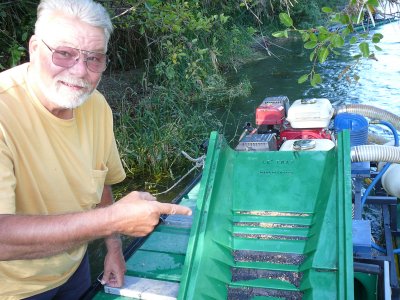 Important note: You have to be extra careful when working with any ropes in moving water to make sure there are no loose ends or unattached lengths of rope that you or your airline can get caught up in. When working in deep and/or fast water like this, you should also rig your airline so that it does not end up wrapped around anything or become caught up in any way that will prevent you from reaching the surface in an emergency. And you should never attempt doing things that you are not comfortable with. Safety is a personal matter. You are the one who is most qualified to know what your limits are. These stories I tell about the things that I personally do are not meant to be an encouragement for you to reach beyond your own capabilities.
Important note: You have to be extra careful when working with any ropes in moving water to make sure there are no loose ends or unattached lengths of rope that you or your airline can get caught up in. When working in deep and/or fast water like this, you should also rig your airline so that it does not end up wrapped around anything or become caught up in any way that will prevent you from reaching the surface in an emergency. And you should never attempt doing things that you are not comfortable with. Safety is a personal matter. You are the one who is most qualified to know what your limits are. These stories I tell about the things that I personally do are not meant to be an encouragement for you to reach beyond your own capabilities.
Jim pointing to Mark’s first clean-up. Not bad!
Our first clean-up weighed in at 1.9 ounces. This was a good start, so we paused to congratulate each other that we had met our initial target of establishing a new high-grade pay-streak within the first two weeks of the season, even if it was on the 14th day.
A day later, we rigged Mark”s 5-incher with the same coupler concept and a swing line supporting an additional 15-feet of suction hose. We launched Mark out into the middle of the river about 80 feet downstream of my dredge. He was into good gold on the first day!
- Here is where you can buy Gold Prospecting Equipment & Supplies.
- Here is where you can buy a sample of natural gold.
- Suction Dredging for Gold
- Fast Water Dredging
- Production Gold Dredging
- Tuning Into the Wavelength of Success
- Never Give Up Hope!
- Schedule of Events
- Books & Videos by this Author


